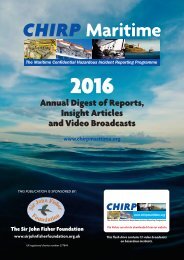CHIRP annual digest 2016 6th
Create successful ePaper yourself
Turn your PDF publications into a flip-book with our unique Google optimized e-Paper software.
<strong>CHIRP</strong> Annual Digest <strong>2016</strong><br />
Article. 35<br />
Ship Approaching a Lock: Power Loss,<br />
Poor Communications and Design<br />
This article outlines a pilot’s experience on approaching a<br />
lock. Slow response to his order for astern power, poor<br />
communication and ship design issues all come to light.<br />
What did the reporters tell us?<br />
Whilst manoeuvring a large pure car carrier into a lock, with<br />
the stern tug at 100% arresting power, more deceleration<br />
was needed. An astern engine order was given, but the<br />
vessel was slowing very slowly. The pilot was not told that<br />
the main engine had failed to start twice. At this point the<br />
Master, rather distraught, asked if the after tug was pulling.<br />
In response to a direct question, the pilot was then informed<br />
that there was a problem with the engine. The pilot took<br />
emergency steps to stop the vessel by laying her against<br />
the rubber coping fenders to act as a friction brake. At this<br />
point the main engine started astern and the vessel was<br />
stopped and moored. Wind at the time was well under the<br />
limiting speed for sailing. The ship’s high minimum speed<br />
was another potentially complicating factor.<br />
Visibility along the side of the ship was limited, and<br />
communications across the bridge difficult. The distance<br />
from centre line to bridge wing was of the order of 16<br />
metres, and key instruments at the conning position were<br />
in three different positions.<br />
What did the ship’s operators tell us?<br />
For environmental reasons newer electronic engines have<br />
reduced fuel injection when starting up. If the engine<br />
misfires, it will automatically try again after 10 seconds<br />
with a slightly increased fuel injection.<br />
According to the company’s internal report, that is what<br />
happened in the lock and is normal. When proceeding at a<br />
low speed in narrow waters, this can of course be seen as a<br />
potential hazard; the standard procedure is therefore to have<br />
the thruster(s) ready for use in addition to suffi cient tugboat<br />
assistance (in this case three in total). The company believes<br />
that both of these requirements were fulfilled. All three<br />
control positions (centre line and wings) are identical.<br />
With a beam of 36.5 metres, this particular vessel follows<br />
the ‘New Panamax’ standard. The company forwards the<br />
vessels’ details to agents in good time before arrivals.<br />
Lessons to be learnt<br />
Main propulsion. Modern propulsion systems with<br />
potential in-built delays and high minimum speeds<br />
present con siderable complication and risk when<br />
manoeuvring at close quarters (for example approaching<br />
locks). The characteristics need to be carefully briefed and<br />
understood between Master and pilot in advance. A<br />
propulsion test should be part of pre-arrival checks.<br />
Communication. Very wide bridges com plicate verbal<br />
communication; a procedure for conning and use of bridge<br />
wing control positions needs to be agreed and tested well<br />
in advance. This would have facilitated an alert to the pilot<br />
about the engine’s failure to engage astern. The Masterpilot<br />
information exchange is a crucial factor; see ‘<strong>CHIRP</strong><br />
Suggests’ below. Visibility. Lack of clear visibility down the<br />
ship’s sides was a serious limiting factor for the pilot. He<br />
and the Master found they had to move rapidly between<br />
positions. Ship design. The reporter makes strong points<br />
in relation to visibility and communication on modern<br />
very large ships, mini mum ships’ speeds, and the ‘engine<br />
fail start’ dimension which (though explained by the 3rd<br />
party) represents a major risk in close manoeuvring.<br />
Failure to share best practice and ship design implications<br />
are also suggested.<br />
<strong>CHIRP</strong> Suggests<br />
Give high priority to timely pre-arrival checks (control<br />
position change overs, and machinery control for<br />
example), and to a comprehensive Master-pilot exchange<br />
covering procedure, the sequence of events, engine<br />
control and limitations, the overall plan, recent defects<br />
and action in the event of potential failures. User input in<br />
design, and the practice of ships’ crews standing by on<br />
build, have in many areas been diluted; at the very least<br />
experienced deck officers including pilots should be<br />
involved in the design of conning positions, especially in<br />
major shipyards which build standard design ships. This<br />
should embrace issues such as visibility from bridge wings,<br />
and – more broadly – machinery control.<br />
The above article was published in MFB 43<br />
Article. 36<br />
Pipeline Pressure Surges<br />
<strong>CHIRP</strong> has recently received several reports relating to<br />
pressure surges in pipelines during tanker operations. The<br />
following reports show various scenarios where pressure<br />
surges can occur.<br />
What did the reporter tell us?<br />
One company noted an increase in loss of cargo con -<br />
tainment incidents due to over pressurisation of pipelines<br />
during cargo operations, the incidents occurring during<br />
changeover of cargo tanks, blowing through cargo lines,<br />
and restarting cargo operations after a stoppage. Analyses<br />
46



